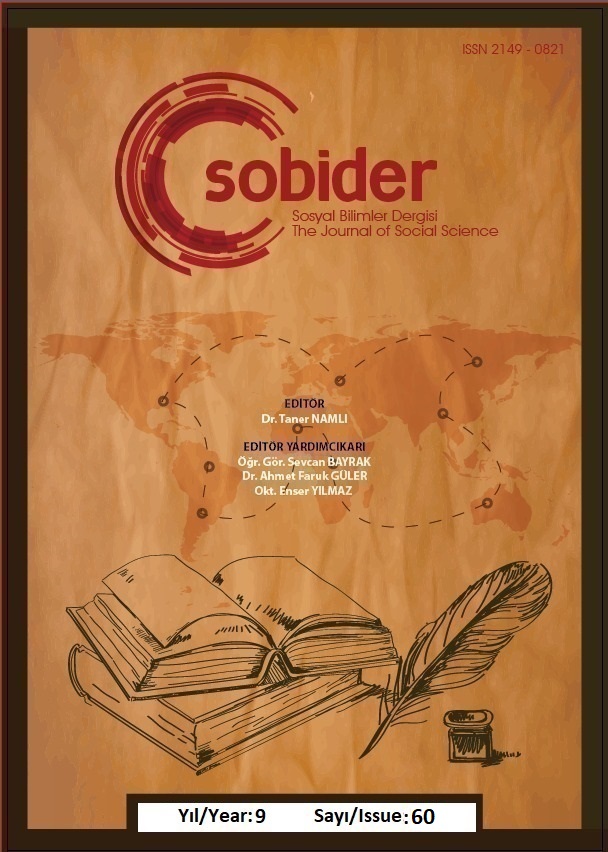Author :
Abstract
- yüzyıl dijital teknolojilerinin, günlük yaşam pratiği içindeki konumunu ve bilgiye ulaşılabilirliğin hızını ifade eden dijital kültür, sağlık, eğlence, eğitim, ulaşım sektörlerinin yanı sıra sanat alanında da etkisini gösterir. Üretim sürecinin en başından itibaren, üretildiği tarihi, kültürel, ekonomik, toplumsal ve siyasi süreci yansıtan sanat eserleri, günümüzde de dijital kültürü tanımlayıcı niteliktedir. Dijital teknolojilerin sanat alanında da varlık gösterdiği günümüzde, sanatçıların ve izleyicilerin birbirleriyle ilişki kurma biçimi, sanat algısı, üretim biçimi, tüketicisine ulaştırılması da değişiklikler göstermeye başlar. Sanat alanında bilgisayar ve dijital teknolojilerin kullanımının sıklaşması yapay zekâ teknolojilerinin de sanat üretiminde kullanıma girmesine zemin hazırlar. Yapay zekâ teknolojileri ile sanat üretimi ve estetik algı farklı bir boyuta taşınır. Halihazırda farklı sanat dallarını bünyesinde barındıran ve bir anlamda disiplinlerarası bir sanat türü olan opera sanatı da hem üretim hem de eserlerin izleyicisine ulaştırılma aşamasında dijital teknolojileri kullanmaya başlar. Ancak dijitalleşen opera sanatının, sanatsal değeri tartışma konusu olmaktadır. Bu çalışmada, dijital ortamda ve yapay zekâ ile üretilen opera örnekleri, kültürel ve sanatsal değer bağlamında ele alınarak incelenecektir.
Keywords
Abstract
Digital culture – signifying the position of 21st century digital technologies within the practices of daily life and the speed of access to information – has an impact upon the field of art, as well as sectors such as health, entertainment, education and transportation. From the very beginning of their production, works of art reflect the historical, cultural, social and political processes of their time. Today, works of art are also descriptive of digital culture. In today's world, where digital technologies are also present in the field of art, the way artists and viewers interact with each other, the perception of art, the way it is produced, and its delivery to the consumer begins to show changes. The frequent use of computers and digital technologies in the field of art paves the way for artificial intelligence technologies to be used in art production. Artificial intelligence technologies take art production and aesthetic perception to a different dimension. The art of opera, which incorporates different fields of art – making it, in a sense, an interdisciplinary art form – starts to make use of digital technologies as well. This is apparent in both the production phase and the transmission of works of art to the audience. However, the artistic value of a digitalised art of opera is subject of debate. In this study, samples of works of opera, which were produced by artificial intelligence in a digital environment, will be examined in context of their cultural and artistic value.
Keywords
- Avcı Tuğal, S. (2017). 0 ve 1’le Şekillenen Dünya. Art- Sanat Dergisi, 8, 573-587.
- Chan, S. (2017). The Old Art and the New: Opera and VR. Harvard Business School Digital Initiative. Erişim adresi: https://digital.hbs.edu/platform-digit/submission/the-old-artand-the-new-opera-and-vr/ (E.T. 05.09.2022).
- Copic, V. (2008). Digital culture in policy documents: the national(istic) perception of cultural diversity- the case of Slovenia. Aleksandra Uzelac, Biserka Cvjetièanin (Ed.), Digital Culture: The Changing Dynamics içinde s. 113-126. Institute for International Relations.
- Gere, C. (2008). Digital Culture. London: Reaktion Books.
- Güney, E. ve Yavuz, H. (2020). Yapay Zekâ ile Sanatsal Üretim Pratiğinde Sanatçının Rolü ve Değişen Sanat Olgusu. Sanat ve Tasarım Dergisi, Sayı 26, 415- 439.
- Lavender, A. (2010). Mapping Intermediality in Performance. Amsterdam University Press.
- Pearlman, E. (2021). Building a ‘Sicko’ AI -AIBO: An Emotionally Intelligent Artificial Intelligent GPT-2 AI Brainwave Opera. In ACM International Conference on Interactive Media Experiences (IMX ’21), New York.
- Rogers, S. (2019). How Immersive Technology Can Bring New Audiences Into Opera. Forbes. Erişim adresi: https://www.forbes.com/sites/solrogers/2019/11/14/how-immersivetechnology-can-bring-new-audiences-into-opera/?sh=35a8c3fd3117 (E.T. 03.09.2022)
- Stewart, J. B. (2015). A Fight at the Opera. The New Yorker, March 23. https://www.newyorker.com/magazine/2015/03/23/a-fight-at-the-opera. ET 24.8.22
- Tempel, M. (2017). Generative Art For All. Journal of Innovation and Entrepreneurship, 6(12), 14.
- Trubnikova, N. ve Tsagareyshvili, S. (2021). Digital challenges for creative industries: case of opera. SHS Web of Conferences 114. DOI:10.1051/shsconf/202111401008
- Uzelac, A. (2008). How to understand digital culture: Digital culture- a resource for a knowledge society? Aleksandra Uzelac, Biserka Cvjetièanin (Ed.), Digital Culture: The Changing Dynamics içinde s. 7-21. Institute for International Relations.
- Vincent, C. C. (2018). Digital scenography in opera in the twenty-first century. Doktora Tezi, Deakin University.
- Fotoğraf 1: Three Tales: https://www.festival-automne.com/en/edition-1997/steve-reich-beryl- korot-music-for-eighteen-musicians-hindenburg (E.T. 07.10.2022)
- Fotoğraf 2: A Vixen's Tale: https://arcade.ltd/a-vixens-tale/ (E.T. 02.10.2022)
- Fotoğraf 3: Current Rising: https://www.youtube.com/watch?v=eY0GioXHBL4 (E.T. 02.10.2022)
- Fotoğraf 4: Noor: https://thetheatretimes.com/ellen-pearlman-brain-opera-telematic- performance-and-decoding-dreams/ (E.T. 02.10.2022)





